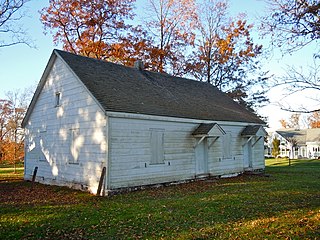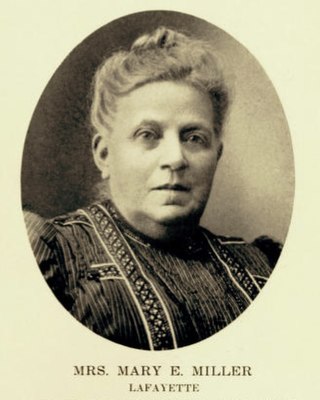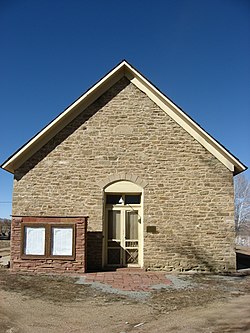
Boulder County is a county located in the U.S. state of Colorado of the United States. As of the 2020 census, the population was 330,758. The most populous municipality in the county and the county seat is Boulder.

Allenspark is an unincorporated town, a post office, and a census-designated place (CDP) located in and governed by Boulder County, Colorado, United States. The CDP is a part of the Boulder, CO Metropolitan Statistical Area. The Allenspark post office has the ZIP code 80510. At the United States Census 2020, the population of the Allenspark CDP was 568.

Ceran St. Vrain, born Ceran de Hault de Lassus de Saint-Vrain, was the son of a French aristocrat who emigrated to the Spanish Louisiana in the late 18th century; his mother was from St. Louis, where he was born. To gain the ability to trade, in 1831 he became a naturalized Mexican citizen in what is now the state of New Mexico. He formed a partnership with American traders William, George and Charles Bent; together they established the trading post of Bent's Fort. It was the only privately held fort in the West.

The Community of True Inspiration, also known as the True Inspiration Congregations, Inspirationalists, and the Amana Church Society) is a Radical Pietist group of Christians descending from settlers of German, Swiss, and Austrian descent who settled in West Seneca, New York, after purchasing land from the Seneca peoples' Buffalo Creek Reservation. They were from a number of backgrounds and socioeconomic areas and later moved to Amana, Iowa when they became dissatisfied with the congestion of Erie County and the growth of Buffalo, New York. Christian worship in the Community of True Inspiration continues, largely unchanged from its inception.

Hygiene is an unincorporated community with a U.S. Post Office in Boulder County, Colorado, United States. Application for the first Hygiene Post Office was made by Jacob Stoner Flory of the United Church of the Brethren on May 28, 1883. Originally named Pella, the community's present name stems from a time when it had a sanatorium to work with tuberculosis patients. St. Vrain Church of the Brethren, a historic Church of the Brethren congregation, is located in the town.
Hannah Connell Barker (1844–1918) was an early resident of Boulder, Colorado. Barker was a teacher, civic leader, businesswoman and land developer in an era when industrious women were not commonly recognized for their contributions. Among other things, Barker served as a teacher; as director of the Boulder Bank; and was instrumental in platting and developing significant parts of the City of Boulder. She also owned the land that was used for the construction of Barker Meadow Reservoir, Boulder's primary source of water.

St. Stephen's Episcopal Church, 1881 is a historical church building in Longmont, Colorado. Also known to be middle of Longmont, Colorado back when it started to develop.

St. Vrain State Park, formerly known as Barbour Ponds, is a Colorado state park. The park hosts year-round camping. It is a popular birding destination, hosting the states largest rookery of Blue Heron, it is home to several other bird species as well including migrating waterfowl, songbirds and the occasional bald eagle. Other park activities include year round fishing and hiking. There is a reservoir at the park named Blue Heron Reservoir.

St. Michael's Catholic Church is a former parish of the Diocese of Davenport. The church is located in the unincorporated village of Holbrook, east of Parnell, Iowa, United States. It is listed on the National Register of Historic Places as St. Michael's Church, Cemetery, Rectory, and Ancient Order of Hibernians Hall in 1983.

Liberty Universalist Church and Feasterville Academy Historic District is a national historic district located near Winnsboro, Fairfield County, South Carolina. The property encompasses four buildings constructed between 1831 and 1845. They are the Liberty Universalist Church and three buildings associated with the Academy: a boarding house, a kitchen, and a school building. The buildings were constructed by the Feaster family.

Sharon Methodist Episcopal Church is located in Sharon Township, a rural area of northwest Clinton County, Iowa, United States. The building is the only remaining structure that remains of a community by the name of Burgess, which was nicknamed Smithtown. The building is commonly referred to as the Smithtown Church. It was listed on the National Register of Historic Places in 2003.

The Klein Meetinghouse is an historic Dunkard meetinghouse that is located in Harleysville, Pennsylvania. Built in 1843, it is the second oldest congregation of the Brethren in the United States, and was established in this area in 1720 when Peter Becker, who led the Brethren to America in 1714, built this meetinghouse. The adjoining cemetery contains Becker's remains.

Old Pine Church, also historically known as Mill Church, Nicholas Church, and Pine Church, is a mid-19th century church located near to Purgitsville, West Virginia, United States. It is among the earliest extant log churches in Hampshire County, along with Capon Chapel and Mount Bethel Church.

People's Methodist Episcopal Church, also known at the Independent Missionary Baptist Church, is a historic church in Colorado Springs in El Paso County, Colorado. Reverend Charles W. Homes was sent from Oskoloosa, Iowa by the Central Jurisdiction of the Methodist Church to build churches in black communities. They church was formed on February 18, 1903, by a group of ex-slaves or children of ex-slaves and began meeting at the Grand United Order of Odd Fellows' Hall. The church was built in 1904 in a neighborhood that was predominantly African-American. Prominent early members include Jesse Bass, Lonnie Bassett, and Frank Loper.

Elkanah J. Lamb was born in Indiana and moved westward through Iowa to Kansas and Nebraska during his early adulthood. He became a minister of the Church of the United Brethren and traveled through the Kansas and Nebraska frontier to preach to people in their homes or school houses. Lamb spent a year in Colorado as a missionary. During that time, he visited Estes Park and climbed Longs Peak. Lamb's slide on Longs Peak is named for his treacherous descent in 1871.

Mary E. Miller (1843–1921) settled in the Territory of Colorado in 1863 with her husband, Lafayette Miller. After her husband died, she founded the town of Lafayette, Colorado, named for her husband. Miller was called the "Mother of Lafayette. She was the first woman bank president in the United States, a philanthropist and an astute businesswoman.

The North St. Vrain Creek Bridge, in Lyons, Colorado, was built in 1955. It was listed on the National Register of Historic Places in 2002.

The Middle Shooks Run neighborhood is located in the city of Colorado Springs, Colorado, United States. The neighborhood's boundaries are Uintah Street to the north, Hancock Avenue to the east, Pikes Peak Avenue to the south, and Wahsatch Avenue to the west. Adjacent to the east side of downtown Colorado Springs, the neighborhood is bisected by the middle section of Shooks Run (creek) and Shooks Run Trail running north to south through the neighborhood.



















